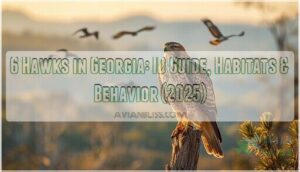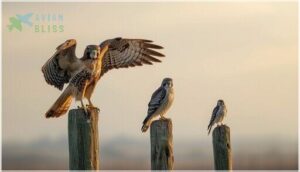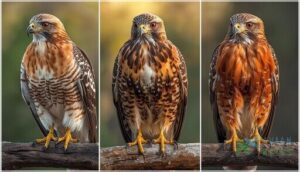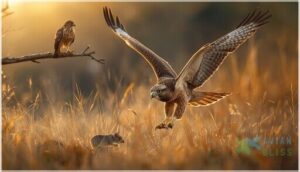This site is supported by our readers. We may earn a commission, at no cost to you, if you purchase through links.
You step outside on a crisp Georgia morning, and there it is—a raptor wheeling overhead, sunlight catching its wings. But which species are you actually looking at? Georgia’s skies host six distinct hawk species year-round or during migration, from the common Red-tailed Hawk perched on highway signs to the elusive Sharp-shinned Hawk darting through your backyard.
Each species has evolved unique hunting strategies, habitat preferences, and field marks that separate the novices from the seasoned birders. Learning to identify hawks in Georgia isn’t just about checking boxes on a life list—it’s about understanding the ecological relationships playing out above your head, whether you’re in Atlanta’s suburbs or the Okefenokee Swamp.
This guide breaks down the physical traits, behaviors, and habitats that’ll help you confidently name every hawk you encounter.
Table Of Contents
- Key Takeaways
- Common Hawk Species in Georgia
- Identifying Hawks: Physical Traits
- Habitats and Distribution Across Georgia
- Hawk Diet, Hunting, and Behavior
- Conservation and Birdwatching in Georgia
- Frequently Asked Questions (FAQs)
- What kind of hawk lives in Georgia?
- What is the difference between a hawk and a falcon in Georgia?
- What attracts hawks to your yard?
- What do Georgia hawks eat?
- How do hawks impact Georgias ecosystem?
- What predators threaten hawks in Georgia?
- How does urbanization affect hawk populations?
- Are there any hawk hybrid species in Georgia?
- Can hawks in Georgia carry diseases?
- When is the best time to see hawk migration in Georgia?
- Conclusion
Key Takeaways
- Georgia hosts six distinct hawk species year-round or seasonally—Red-tailed, Red-shouldered, Broad-winged, Cooper’s, Sharp-shinned, and Northern Harrier—each adapted to specific habitats from urban areas to wetlands, with identification relying on physical traits like wing shape, tail patterns, and plumage variations.
- Each hawk species employs specialized hunting strategies shaped by its anatomy: Red-tailed Hawks perch-hunt from elevated positions, Cooper’s and Sharp-shinned Hawks ambush songbirds with agility in forests, Red-shouldered Hawks target amphibians in wetlands, and Northern Harriers use owl-like facial discs to hunt low over grasslands.
- Conservation efforts including DDT bans and the Migratory Bird Treaty Act have stabilized or increased most hawk populations in Georgia, though challenges like habitat loss, vehicle collisions, and rodenticide poisoning continue to threaten individual survival, with rehabilitation success rates hovering around 16-23%.
- Prime hawk-watching opportunities occur during fall migration from late August through mid-November, particularly mid-September through October, when locations like Kennesaw Mountain National Battlefield Park record over 20,000 raptors passing through, with Broad-winged Hawks forming massive “kettles” numbering in the thousands.
Common Hawk Species in Georgia
Georgia’s skies and forests are home to six distinct hawk species, each with unique traits that help you tell them apart in the field.
From the common Red-tailed Hawk soaring over open pastures to the elusive Northern Harrier gliding low over marshes, these raptors occupy different habitats across the state.
Let’s take a closer look at each species you’re likely to encounter.
Red-tailed Hawk
You’ll recognize the Red-tailed Hawk by its namesake rusty tail and broad wings spanning 43 to 57 inches. This adaptable raptor thrives across Georgia’s varied landscapes, from urban parks to open fields, showing considerable geographic variation in plumage.
With hunting success driven by keen eyesight, you can spot these common raptors perched on roadside posts, scanning for small mammals below. They’re known to be opportunistic predators, supplementing their diet by scavenging when necessary.
Red-shouldered Hawk
You’ll find the Red-shouldered Hawk thriving in Georgia’s deciduous forests and swamp habitats year-round, where their distinctive, whistled call echoes through the canopy. This species shows strong forest dependence, preferring wooded areas near water for hunting small mammals and amphibians.
Population trends indicate stable or increasing numbers in Georgia since pesticide restrictions were implemented, making raptor identification easier for you during woodland outings. As birds of prey, hawks play a key role in the ecosystem. You can find more about Georgia hawks on the linked website.
Broad-winged Hawk
During spring and fall, you’ll witness one of nature’s most impressive spectacles when Broad-winged Hawks pass through Georgia in massive “kettles,” sometimes numbering in the thousands. These compact raptors, with their distinctive black-and-white banded tails and broad wings, prefer dense deciduous forests during their breeding season.
During spring and fall migrations, Broad-winged Hawks pass through Georgia in massive flocks called kettles that can number in the thousands
Unlike year-round residents, their flocking behavior and migration patterns make hawk identification easier when they’re moving between northern breeding grounds and South American wintering sites.
Cooper’s Hawk
Cooper’s Hawks in Georgia have bounced back since their mid-century decline from DDT and hunting, achieving population stability across urban and suburban areas.
You’ll recognize this medium-sized accipiter by its steely blue-gray back, rounded tail, and impressive hunting agility as it weaves through trees using stealth tactics to catch songbirds.
These adaptable raptors thrive in forest edges and backyards, demonstrating exceptional urban adaptations in their nesting behavior throughout the state.
Sharp-shinned Hawk
As Georgia’s smallest hawk species, the Sharp-shinned Hawk arrives during winter migration, showcasing impressive agile flight through dense forests where it specializes in songbird predation.
You’ll spot this accipiter by its blue-gray back, rufous chest, and distinctive straight tail as it maneuvers with outstanding speed.
Population trends indicate stable numbers, though habitat dependence makes forest conservation vital for these skilled raptors.
Northern Harrier
During winter, you’ll encounter the Northern Harrier gliding low across Georgia’s marshes and grasslands, its owl-like facial disc scanning for prey—a hunting technique unique among hawks. Watch for these distinctive features:
- Owl-like facial disc for sound-based hunting
- Low-flying search patterns over open terrain
- White rump patch visible during flight
- Polygynous behavior with multiple mates
- Wintering habits in Georgia’s open habitats
This raptor’s migration patterns bring excellent bird watching opportunities across the state.
Identifying Hawks: Physical Traits
Spotting a hawk overhead is one thing, but knowing which species you’re looking at requires a closer look at the details. Each hawk in Georgia has distinct physical traits, from body size and wing shape to color patterns and tail markings.
Let’s break down the key features that’ll help you confidently identify these raptors in the field.
Size and Shape Differences
You’ll notice that body mass and wing span vary dramatically among hawk species in Georgia, making size your first clue in bird identification. Red-tailed Hawks weigh up to 3.5 pounds with wingspans reaching 57 inches, while Sharp-shinned Hawks barely tip the scales at 3.1 ounces.
Tail lengths and overall shape also differ—accipiters like Cooper’s Hawks have blocky heads and long tails, whereas buteos display broader, rounded profiles perfect for soaring.
Plumage and Color Patterns
Plumage patterns offer you a reliable window into hawk species identification, especially when feather morphology and color variation converge. Adult Red-shouldered Hawks display rufous-peach barring across their underparts, contrasting with their mottled black-and-white backs, while Cooper’s Hawks show reddish chest barring in mature birds.
Molt cycles transform juvenile Sharp-shinned Hawks’ vertical brown streaks into adults’ orange horizontal bars, demonstrating how characteristics of hawk species in Georgia shift with age and season.
Tail and Wing Characteristics
Wing span and tail feathers function like a hawk’s flight signature, revealing species identity even at a distance. You’ll notice how aerodynamic shape and feather structure create distinct flight patterns across hawk species in Georgia, with each adaptation reflecting specialized hunting lifestyles.
- Red-tailed Hawks: Broad, rounded wings (114-133 cm span) and short reddish tail enable high-altitude soaring
- Sharp-shinned Hawks: Compact wings (14.1-22.9 cm) with medium banded tail allow forest maneuvering
- Cooper’s Hawks: Longer rounded wings and tail tip distinguish them from Sharp-shinned relatives
- Red-shouldered Hawks: Long tails with narrow white bands contrast against black plumage
- Northern Harriers: Extensive wingspan (97-122 cm) enables low, steady hunting flights over grasslands
These characteristics of hawk species distinguish types of hawks in Georgia during field observation.
Key Field Marks for Identification
You’ll find that facial disk structure separates Northern Harriers from other hawk species in Georgia, while flight silhouette reveals Cooper’s versus Sharp-shinned identity.
Underwing patterns, particularly patagial marks on Red-tailed Hawks and crescent windows on Red-shouldered Hawks, provide reliable confirmation during flight.
Plumage variations and tail markings complete your avian species identification toolkit, with each hawk species’ characteristics reflecting distinct evolutionary adaptations for survival.
Habitats and Distribution Across Georgia
Hawks in Georgia don’t just pick any old spot to call home—each species has carved out its own niche based on what it needs to hunt, nest, and thrive. You’ll find them scattered across cities, forests, open fields, and wetlands, with some sticking around year-round while others pass through with the seasons.
Let’s look at where you’re most likely to spot each species across the state.
Urban and Suburban Areas
Over the past two decades, Georgia’s cities and suburbs have become unexpected havens for raptors, with Cooper’s Hawk sightings at feeders jumping fourfold. Urban habitats now support thriving populations of these skilled predators, who’ve adapted remarkably well to human impact and city life.
Key urban hawk adaptations you’ll notice:
- Red-tailed and Red-shouldered Hawks dominate metropolitan Atlanta’s parks and greenways
- Cooper’s Hawks hunt songbirds around backyard feeders with impressive agility
- Hawks perch on utility poles and streetlamps, turning city infrastructure into hunting platforms
- Winter concentrations peak as abundant prey—pigeons, sparrows, and urban rodents—draw raptors cityward
- Nesting occurs on buildings, billboards, and tall trees throughout residential neighborhoods
Bird watching in Georgia reveals how these adaptable raptors thrive in suburban ecology, demonstrating nature’s resilience.
Forests and Woodlands
Georgia’s mature forests provide essential ecosystem services for raptors, especially Red-shouldered Hawks who thrive in bottomland hardwoods and swamp edges. Forest ecology here matters—habitat fragmentation reduces nesting success, but protected tracts maintain stable populations.
You’ll spot Broad-winged Hawks in dense deciduous stands with intact tree canopy, while Cooper’s Hawks patrol woodland edges. In woodland management areas, sharp-shinned Hawks hunt through mixed forest patches year-round.
Grasslands, Fields, and Wetlands
Open country tells a different story for Georgia’s raptors. Northern Harriers glide low over marshes and grasslands, where they comprise the majority of hawk sightings in these habitats. Red-tailed Hawks adapt well to agricultural fields, while habitat loss has reduced nesting success in fragmented landscapes by over 30% statewide.
Land management practices like controlled burns directly influence hunting trends and conservation impacts for these specialized raptors.
Seasonal Ranges and Migration Routes
Beyond fixed territories, you’ll notice striking seasonal shifts as hawks follow ancient migratory bird patterns. Understanding hawk migration patterns reveals dramatic movements across Georgia’s corridor bottlenecks:
- Broad-winged Hawks depart between mid-September and late September, with 95% passing in two concentrated weeks
- Red-tailed Hawks peak during the first week of November
- Northern Harriers arrive as winter residents from late October through early April
- Rough-legged Hawks appear in December and January from tundra breeding grounds
Migration timing depends on thermal availability and northwest winds following cold fronts. Monitoring data from continuous counts since 1934 tracks these raptor migration patterns, documenting species patterns that help assess population health and conservation needs.
Hawk Diet, Hunting, and Behavior
Hawks in Georgia have refined their hunting game over thousands of years, each species carving out its own niche in the food chain. From the lightning-fast ambushes of woodland hunters to the patient aerial scouts of open fields, these raptors use distinct strategies to catch their next meal.
Here’s what you need to know about how Georgia’s hawks hunt, what they eat, and how their behavior shifts with the seasons.
Typical Prey for Each Species
Hawks in Georgia exhibit notable dietary adaptations based on their size and hunting niche. Red-tailed Hawks primarily focus on small mammals like voles and rabbits, while Cooper’s and Sharp-shinned Hawks specialize in songbirds, with songbirds comprising 90% of the Sharp-shinned’s diet. Red-shouldered Hawks favor amphibians and reptiles in wetland areas, and Northern Harriers rely on voles and small mammals in open grasslands.
| Species | Primary Prey |
|---|---|
| Red-tailed Hawk | Mammals (voles, rabbits, ground squirrels) |
| Cooper’s Hawk | Medium-sized birds, occasionally small mammals |
| Sharp-shinned Hawk | Songbirds (90% of diet), insects, small mammals |
| Red-shouldered Hawk | Amphibians, reptiles, small mammals, insects |
Prey size varies considerably among raptors. Red-tailed Hawks can tackle larger prey like rabbits and pheasants, while Sharp-shinned Hawks target smaller songbirds at feeders. Seasonal availability also influences raptor behavior; Broad-winged Hawks consume more insects during the breeding season, and urban prey like pigeons and starlings support Cooper’s Hawks in suburban neighborhoods. These dietary adaptations reflect each species’ physical build and preferred habitat, ensuring hunting success across diverse Georgia ecosystems throughout the year.
Hunting Techniques and Strategies
When you watch raptors hunt, you’ll notice each species employs distinct methods refined over thousands of generations. Types of hawks in Georgia showcase striking tactical variation:
- Perch hunting dominates Red-tailed Hawk behavior, with individuals waiting an average of 24 minutes before striking from elevated locations 12 meters high.
- Aerial maneuvers include stooping dives (21% of attacks) and rolling grabs (66% of level-flight pursuits), allowing birds of prey to intercept airborne targets.
- Opportunistic behavior surfaces during winter when Red-shouldered Hawks wade into shallow water for frogs or scavenge roadkills alongside their usual prey.
Seasonal shifts trigger tactical adjustments as raptor behavior and habitat pressures change throughout the year.
Adaptations for Survival
When survival depends on split-second decisions, Georgia’s raptors rely on specialized features honed by natural selection. Visual acuity reaches 8–10 times human capability, while talon strength exceeds 200 psi for rapid prey immobilization. Feather camouflage conceals broad-winged hawks in forest canopies, and nesting strategies—including 72% nest reuse rates—reduce predation risk, ensuring successful reproduction across diverse avian ecology contexts.
| Adaptation Type | Species Example | Survival Benefit |
|---|---|---|
| Visual Acuity | Red-tailed Hawk | Detects prey 1.6 km away |
| Talon Strength | Cooper’s Hawk | Grip force over 200 psi |
| Feather Camouflage | Broad-winged Hawk | Concealment during hunting |
Seasonal Shifts in Diet and Behavior
Georgia wildlife undergoes dramatic shifts across the calendar, and raptors mirror these changes in striking ways. During breeding season, you’ll notice Red-tailed Hawks increase mammalian prey consumption as nestling energy demands spike. Broad-winged Hawks switch from mammals to insects and amphibians post-nesting, while migration patterns trigger behavioral adaptations like “kettling.”
Weather impact directly affects prey availability—spring rains temporarily reduce mammal hunting success, forcing dietary flexibility critical for avian ecology and wildlife conservation.
Conservation and Birdwatching in Georgia
Hawks in Georgia have come a long way from the days when DDT and persecution threatened their survival. Thanks to protective legislation like the Migratory Bird Treaty Act and ongoing habitat conservation efforts, most species are doing well, though some still face challenges.
Whether you’re interested in supporting these raptors or simply want to observe them in the wild, here’s what you need to know about conservation status, where to watch hawks, and how to do it responsibly.
Conservation Status of Georgia Hawks
You’ll find that most hawks in Georgia are holding steady thanks to strong legal protections and conservation efforts. The Migratory Bird Treaty Act shields all native hawks from harm, while raptor conservation efforts focus on population monitoring and addressing threats like habitat loss, vehicle collisions, and rodenticide poisoning that challenge wildlife conservation in Georgia.
- Red-tailed and Cooper’s Hawk populations have remained stable or increased since DDT bans and hunting restrictions took effect in the mid-20th century
- Red-shouldered Hawks show a promising 76% first-year survival rate based on Georgia sighting records, indicating successful habitat preservation for hawks
- Broad-winged and Sharp-shinned Hawks face long-term migration count declines, though numbers remain near average at some monitoring sites
- Rehabilitation success rates hover around 16-23% for injured raptors, with most mortalities resulting from vehicle collisions, secondary poisoning, or incurable trauma
- No common Georgia hawk species currently holds threatened or endangered status at state or federal levels, reflecting effective raptor conservation
Habitat Protection and Restoration
Protecting habitat requires more than good intentions—it demands action. You can bolster ecosystem restoration and raptor conservation efforts by joining volunteer workdays that remove invasive species and install native plantings across Georgia’s landscapes. These wildlife management initiatives restore forest edges, riparian corridors, and grasslands, strengthening habitat preservation for hawks and environmental sustainability.
| Project Focus | Location Example | Conservation Impact |
|---|---|---|
| Native grassland restoration | Evans County pastures | Enhances prey availability for hunting hawks |
| Invasive species removal | Chattahoochee RiverLands | Improves migratory stopover habitat quality |
| Coastal dune stabilization | Jekyll Island | Protects nesting areas through habitat conservation |
| Riparian forest recovery | South River Watershed | Advances breeding populations through wildlife preservation |
Best Places for Hawk Observation
Once you’ve strengthened raptor habitats, experiencing these birds firsthand deepens your connection to conservation. Kennesaw Mountain National Battlefield Park stands out among migration hotspots, where over 20,000 raptors pass through each fall.
You’ll find accessible viewing platforms at Okefenokee National Wildlife Refuge and coastal sites like Harris Neck. Seasonal patterns peak mid-September through October, when guided tours reveal the full spectacle of wildlife observation and birding in Georgia, connecting you to raptors and their habitats through immersive birdwatching experiences.
Ethical Birdwatching and Photography Tips
Watching hawks up close enriches your birding in Georgia experience, but minimizing disturbance protects their breeding success. Keep safe distances—at least 300 feet from nests—and respect habitats by staying on trails.
Ethical photography means skipping flash near roosts and avoiding playback calls during nesting. When you prioritize wildlife observation over the perfect shot, you’re safeguarding these raptors for future birdwatching adventures.
Frequently Asked Questions (FAQs)
What kind of hawk lives in Georgia?
Georgia hosts six hawk species: Red-tailed, Red-shouldered, Broad-winged, Cooper’s, Sharp-shinned, and Northern Harrier. Species prevalence varies by habitat variation and season, with identification challenges arising from similar plumage patterns, making conservation concerns critical for bird species protection.
What is the difference between a hawk and a falcon in Georgia?
You’ll notice the main difference in their wing morphology and hunting styles. Hawks have rounded wings and broad tails, while falcons sport pointed wings with narrow tails—features that shape their distinct flight patterns across Georgia’s skies.
What attracts hawks to your yard?
Your yard becomes a hawk magnet when prey availability increases—think small mammals near bird feeders, tall trees for nesting sites, and water sources nearby. Landscaping choices and seasonal factors also influence Wildlife in Georgia birdwatching opportunities.
What do Georgia hawks eat?
Hawks in Georgia are carnivores with diverse diets driven by prey availability and hunting adaptations. Red-tailed hawks eat small mammals and reptiles, while Cooper’s and Sharp-shinned hawks specialize in birds, showing dietary overlap among raptors.
How do hawks impact Georgias ecosystem?
You’ll find hawks playing an important role in prey regulation and ecosystem health by controlling rodent populations, removing weak individuals, and maintaining ecological balance across habitat niches—from forests to urban ecosystems.
What predators threaten hawks in Georgia?
Larger raptors like Bald Eagles and owls threaten hawks in Georgia, while raccoons, opossums, and crows raid nests.
Human impact through collisions and habitat loss increases hawk vulnerability, challenging ecological balance.
How does urbanization affect hawk populations?
Urbanization creates a split reality for hawk populations. While habitat fragmentation and mortality factors like collisions pose significant threats, adaptable species such as Cooper’s Hawks thrive by exploiting urban prey.
Effective wildlife management and conservation strategies have led to an increase in occupancy for these resilient birds.
Are there any hawk hybrid species in Georgia?
No documented hybrid hawks exist in Georgia. Genetic analysis and field observations confirm strong hybridization barriers between species, maintaining species diversity.
Conservation impacts remain minimal, though future research continues monitoring avian species identification and ecological factors statewide.
Can hawks in Georgia carry diseases?
Yes, hawks can carry diseases. While zoonotic risks remain low, parasite prevalence studies show infection rates exceeding 66%.
Avian influenza has impacted Georgia raptors, making disease monitoring essential for ecosystem health and wildlife conservation efforts.
When is the best time to see hawk migration in Georgia?
Peak migration dates run late August through mid-November, with September and October offering prime raptor migration viewing. Cold fronts trigger concentrated flights, making coastal hotspots and elevated areas ideal for birdwatching in Georgia during these migration trends.
Conclusion
Learning to spot hawks in Georgia transforms every outdoor moment—whether you’re scanning power lines, walking wooded trails, or watching marshes at dawn. The six species covered here each play distinct roles in local ecosystems, controlling prey populations and reflecting habitat health.
With practice identifying size, plumage, and behavior, you’ll move from guessing to knowing. Keep binoculars handy, revisit field marks regularly, and trust your observations. The raptors are already there—you’re simply learning to see them.
- https://birdfeederhub.com/hawks-in-georgia/
- https://faculty.cnr.ncsu.edu/christophermoorman/wp-content/uploads/sites/9/2016/02/MoormanJournalofRaptorResearch.pdf
- https://bwdmagazine.com/travel/regions/georgia-birding-season-fall/
- https://oehha.ca.gov/epic/impacts-biological-systems/bird-wintering-ranges
- https://www.vedantu.com/geography/scrubland











